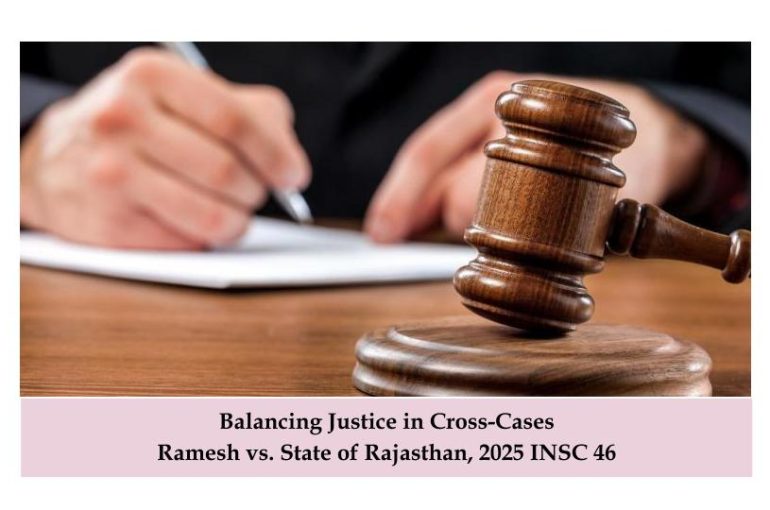Balancing Justice in Cross Cases Ramesh V. State of Rajasthan, 2025 INSC 46
The Supreme Court of India, rendered a judgment addressing a prolonged family feud that escalated into violent clashes and legal battles. The case highlighted significant procedural and substantive issues, including the principles governing cross-cases, the application of the Probation of Offenders Act, 1958, and the need for proportionality in sentencing.
Background of the Case
On January 1, 1993, a violent clash occurred in Gadhmora village, Rajasthan, involving two factions of the same extended family. This long standing family feud escalated into a physical altercation, resulting in injuries on both sides. The incident led to the registration of two separate First Information Reports (FIRs) at the same police station, each presenting conflicting versions of the events.
FIR No. 1/1993: Filed by the complainant Chhotu, this FIR alleged that Ramesh (the Appellant) and five other members of his family attacked them at around 7:00 a.m. with weapons, causing grievous injuries. The Accused were charged under Sections 307 (attempt to murder), 148 (rioting armed with deadly weapons), 326 (grievous hurt), 323 (causing hurt), and 452 (house trespass).
FIR No. 9/1993: Filed by the opposing group, this FIR Accused Chhotu and his relatives of assaulting Ramesh’s group around the same time. The Accused were charged under Sections 148, 341, 323, 324, and 149 IPC, alleging the use of deadly weapons and causing injuries.
Both FIRs were investigated separately, leading to two parallel trials. Session Case No. 31/1993, based on FIR No. 1/1993, resulted in the conviction of Ramesh and others, while Criminal Case No. 584/1998, based on FIR No. 9/1993, ended with probation for Chhotu and his group due to a settlement reached during the trial. Despite being cross-cases stemming from the same incident, the two cases were not consolidated, leading to separate adjudication and inconsistent outcomes.
Trial Court Proceedings
The trial for Session Case No. 31/1993 was conducted in the Court of the Additional District and Sessions Judge, Gangapur City, Rajasthan. This case originated from FIR No. 1/1993, which Accused Ramesh (Appellant) and five others of violent assault against members of the opposing family group. The incident stemmed from a deep-rooted family feud that escalated into a violent clash on January 1, 1993.
The Prosecution presented evidence, including witness testimonies and medical records, establishing that serious injuries had been inflicted upon the complainant’s group. The trial court convicted Ramesh under Sections 148, 307/149, 326, 323, and 452 (house trespass after preparation for assault) of the Indian Penal Code (IPC). Ramesh and five others received various sentences, with the harshest punishments reserved for charges under Section 307 IPC, indicating the court’s view that the Accused’s actions were premeditated and gravely injurious.
The Trial Court, however, did not consolidate this case with the related Criminal Case No. 584/1998, arising from FIR No. 9/1993, which was a counter-complaint filed by the opposing family group. This procedural oversight fragmented the legal proceedings and prevented a unified analysis of the interconnected incidents.
High Court Appeal
Ramesh and the other Accused appealed to the High Court of Judicature for Rajasthan, challenging the trial court’s judgment. In S.B. Criminal Appeal No. 562/1995, the High Court examined the evidence, the nature of injuries, and the procedural irregularities, particularly the absence of a unified trial for the cross-cases. The High Court found merit in some of the Appellants’ arguments, leading to a mixed outcome.
- Acquittals and Partial Relief:
- Four co-Accused—Smt. Rupi, Smt. Janaki, Shalla @ Suresh, and Shambhu—were acquitted of all charges due to insufficient evidence or mitigating circumstances.
- Ramesh, however, received partial relief as his convictions under Sections 307, 148, and 149 were set aside. The High Court reasoned that while the injuries inflicted were serious, there was insufficient evidence to establish the intent to commit murder.
- Upheld Convictions and Modified Sentences:
The High Court affirmed Ramesh’s conviction under Sections 326, 325 (voluntarily causing grievous hurt), 452 (house trespass), and 323. However, the sentences were modified as follows:- Section 326: Rigorous imprisonment for six months and a fine of ₹5,000, with one month’s imprisonment in case of default.
- Section 325: Simple imprisonment for two months and a fine of ₹1,000, with seven days’ imprisonment in case of default.
- Section 452: Simple imprisonment for one month and a fine of ₹1,000, with seven days’ imprisonment in case of default.
- Section 323: Simple imprisonment for seven days.
- Denial of Probation:
The High Court acknowledged the prolonged pendency of the case (over 27 years) and the absence of any prior criminal record for Ramesh. However, it declined to extend the benefit of the Probation of Offenders Act, 1958, stating that granting probation for an offense as severe as grievous hurt under Section 326 IPC could send a negative message to society.
Supreme Court Judgment
Dissatisfied with the High Court’s refusal to grant probation, Ramesh appealed to the Supreme Court of India. The Supreme Court undertook a comprehensive review of the facts, procedural history, and the High Court’s reasoning. It delivered a balanced and nuanced judgment, addressing key aspects of justice, including reconciliation, proportionality in sentencing, and consistency in cross-cases.
- Recognition of Cross-Cases:
The Supreme Court emphasized that the incidents underlying FIR No. 1/1993 and FIR No. 9/1993 were part of a single chain of events involving the same families on the same day. Citing precedents like Nathi Lal v. State of U.P. r 1990 Supp. SCC 145 and Sudhir v. State of M.P. (2001) 2 SCC 688, the Court noted that cross-cases should ideally be tried together before the same judge to ensure consistency and holistic adjudication. The fragmented trials in this case led to inconsistent outcomes, as one group received probation while the other faced harsher sentences. - Settlement and Probation:
The Court acknowledged that during the trial of Criminal Case No. 584/1998, the parties had reached an amicable settlement. The Accused in that case were granted probation under Section 4 of the Probation of Offenders Act, 1958, considering their advanced age, lack of prior convictions, and the 25-year delay in trial proceedings. The Supreme Court found no reason to deny Ramesh the same benefit, especially given the absence of criminal antecedents and his advanced age (70 years). - Application of Article 142:
Exercising its extraordinary powers under Article 142 of the Constitution, the Court granted probation to Ramesh. It underscored that justice in such cases must prioritize reconciliation and societal harmony over retribution, particularly when both parties belong to the same family and have buried their differences. - Final Directions:
The Supreme Court allowed Ramesh’s appeal and directed his release on probation. He was required to furnish a personal bond of ₹10,000 with a surety for six months, along with an undertaking to maintain peace and good behavior.
Conclusion
This case is a profound example of the judiciary’s evolving approach to criminal justice, prioritizing reconciliation and proportionality over punitive measures. The trial court’s rigid stance, the High Court’s balanced yet cautious approach, and the Supreme Court’s emphasis on restorative justice illustrate the layered dynamics of legal adjudication in India. By granting probation to Ramesh, the Supreme Court reaffirmed its commitment to fairness, consistency, and the broader objective of societal harmony.
Shikha Pandey
Associate
The Indian Lawyer & Allied Services
Please log on to our YouTube channel The Indian Lawyer Legal Tips and learn about different aspects of the law. Our latest video is on “Understanding Lease Agreement” that may be viewed on the link below:
https://youtu.be/dzxKUx9qh9M?si=22GhuEYb1Sa_RLXX





































Leave a Reply